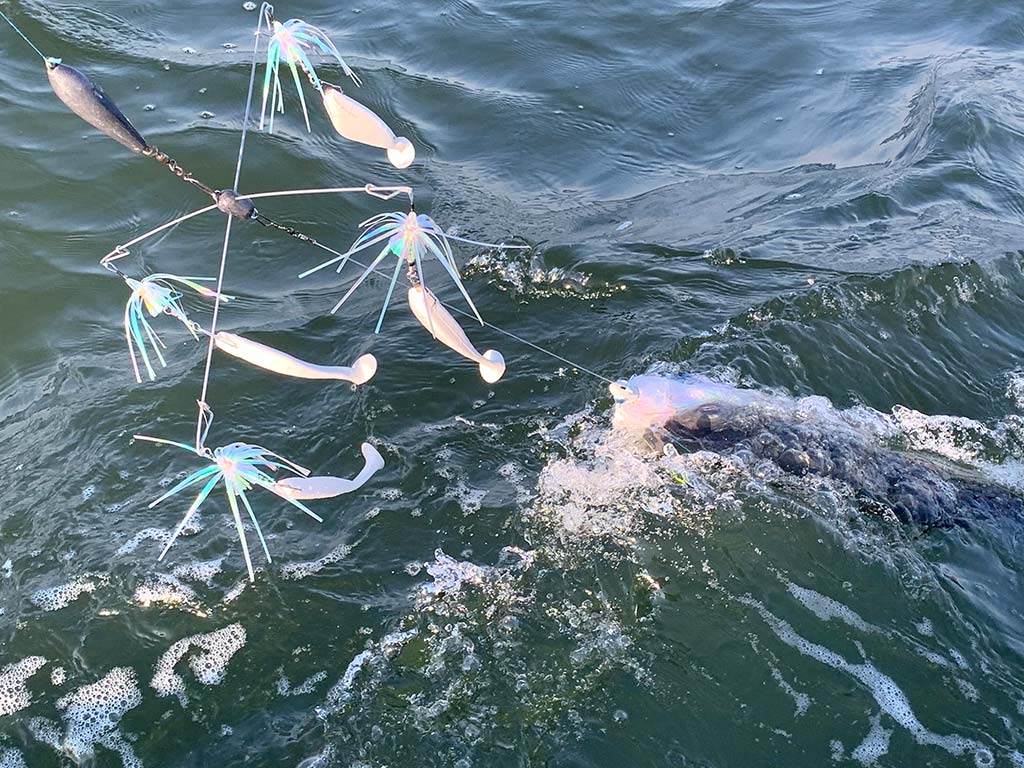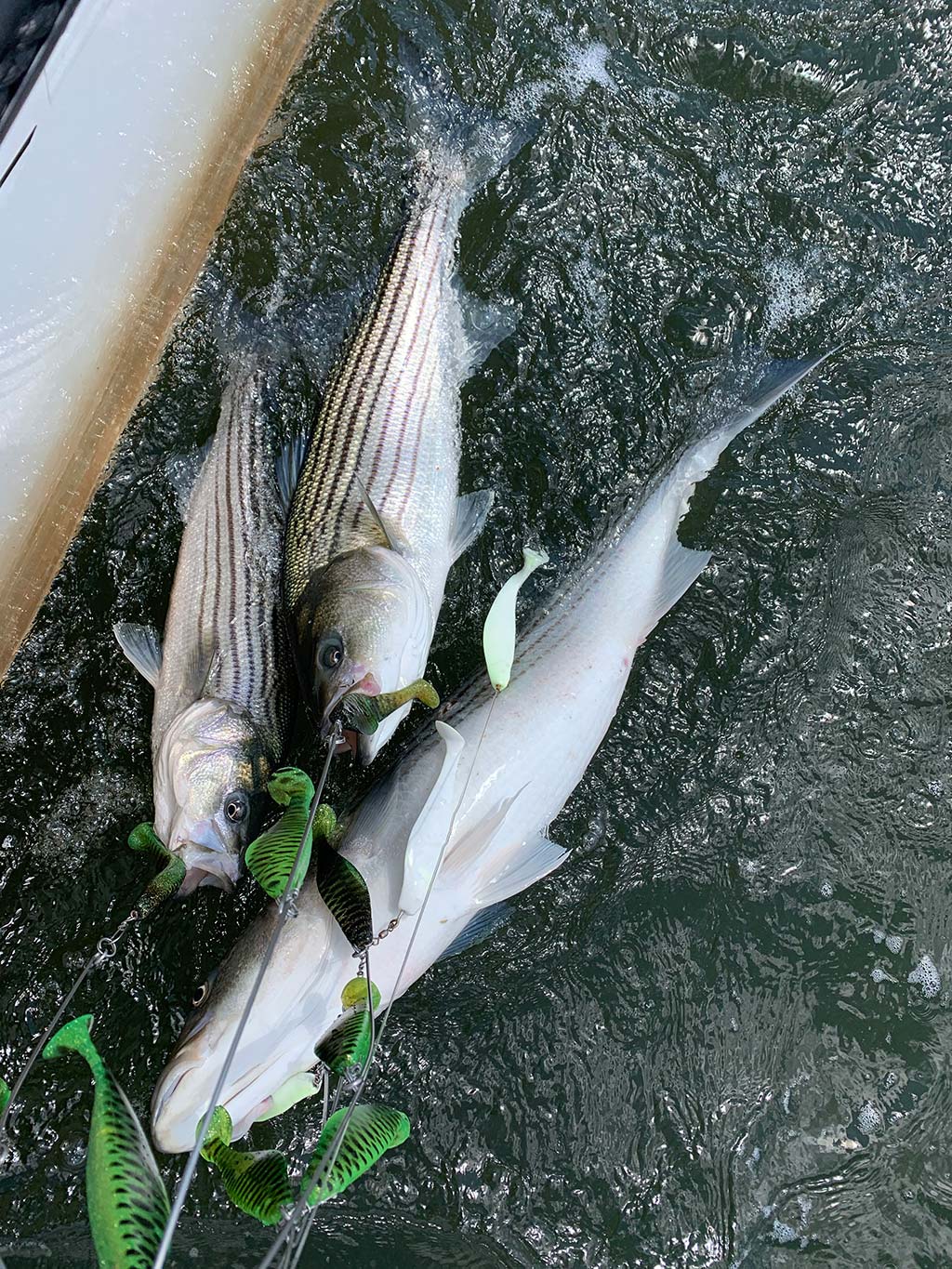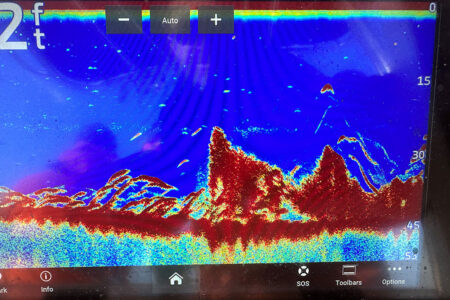
Umbrella rigs are a terrific striper tool for every captain
The feverish bass bite gradually began to subside. Livelining, casting shads and trolling mojos were all slowing down as the fish began showing signs of lockjaw. At that point, we pivoted techniques from casting to dragging umbrella set-ups.
An umbrella rig is designed to mimic a school of baitfish by utilizing metal arms adorned with numerous shad or sand eel imitations. There are many companies that produce both four- and six-arm umbrellas. They are typically set up so that only the offerings on the perimeter contain a hook, the interior baits are just for show. Down the middle, a single shad or sand eel is dropped back and appears separated from the school.
Since we were still marking plenty of striped bass, we knew a tactical change might manufacture a bite during the slowdown. Bass don’t feed non-stop; They are sometimes ravenous and other times extremely picky or uninterested. The tide, moon, water temp, time of day and forage movements can all have an influence on fantastic or fussy fishing.
Out came the umbrella rigs. We ran two Bluewater Candy Lures, six-arm umbrellas off each side of the boat and extending out via the use of outrodders. These were entirely composed of 6-inch shads. Down the middle and directly off the stern, we ran two Bluewater Candy Lures Striperbrellas which consist of four 6-inch shads and a 9-inch shad attached to a 4-ounce mojo. This is one of my favorites.
It didn’t take long to get doubled up on stripers. Both a center Striperbrella and a six-arm umbrella were struck and the Penn Fathom reels sounded. I try to stay at troll speed for a few seconds after an initial strike in order to tempt additional bass into attacking which precipitates doubles and triples regularly.
My crew began to reel the fish and raise the other lines because umbrella rigs contain enough hardware and hooks that if they are allowed to sink to the bottom, they will pick up mud, seaweed and other junk. Moreover, the plethora of hooks function like grappling devices and they can easily be snagged in an area with live bottom or structure. Hence, we reel ours completely in or half way to the surface where they still might coax a strike.

Upon the bass coming to the surface, I carefully grabbed the leader line and brought the fish on board, much like an offshore fisherman might “sling” a mahi into the boat, but with more care to keeping the fish and hooks away from body parts. Netting an umbrella-hooked bass can turn into a mess so I opt for just lifting the fish in when they are shorts or small keepers. Once in the boat, immobilizing the fish is important for safety and faster releases. For larger specimens, I carefully lip the bass or place my hands underneath the chin to lift them in. When vertically lifted, they settle down and I can use my other hand to choke the umbrella rig, all the while the rod is in a holder.
If fish aren’t biting for 10 minutes or so I like to check all the lines for unwanted debris. When removing umbrella rigs from their pouches or tubes, the arms usually need to be bent outward from the middle several inches in order to create the proper appearance. Shads can rip and need to be replaced regularly, often during the outing itself.
When deploying umbrella rigs, it’s imperative that they are laid in the current before slowly dropping them back to troll depth. I thumb the spool so they don’t just sink in random fashion. This can cause the center line with the “follower” shad to get fouled the other arms.
Fifty-pound test or heavier braided line is the order of the day, since these rigs put a lot of pressure on the rod, reel and line. Those not using braid, utilize wire line outfits for success. If anglers hook-up with fish that simply won’t come to the boat and feels more like a cinder block, there is a good chance the fish has been hooked by two or three hooks and is coming up sideways. In this instance, the boat should be taken out of gear after all the other lines are reeled in and the fish should be brought to the surface quickly to aid in the fish surviving and to avoid bent hooks.
Although umbrellas are outstanding lures fished on a soft bite, they can fill the boat anytime making them a terrific tool for every captain.




